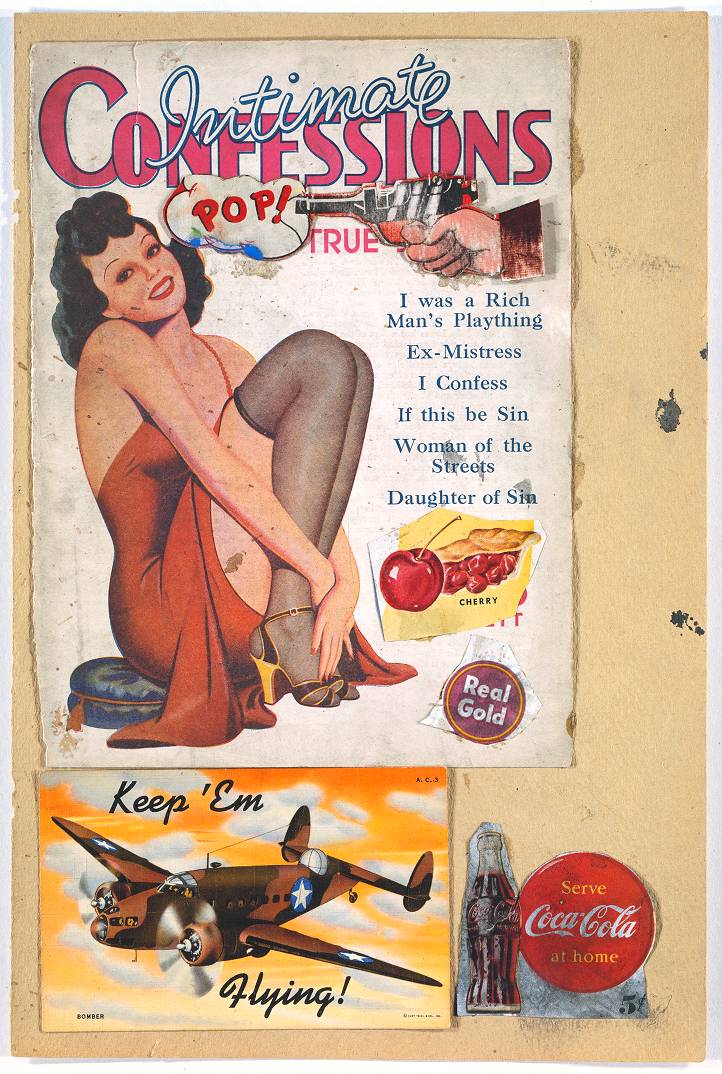Sir Eduardo Paolozzi
I Was a Rich Man's Plaything

Sir Eduardo Paolozzi, I was a Rich Man's Plaything 1947 © Sir Eduardo Paolozzi 2002. All rights reserved, DACS.
Orientation
This work of art is a collage. It is made from different pieces of commercially printed paper stuck onto a single piece of card that is slightly narrower than a single page of a tabloid newspaper. The biggest collage element takes up the top two thirds of the work. It is the cover of a magazine called ‘Intimate Confessions’. Dominating the cover of ‘Intimate Confessions’ and therefore the artwork as a whole, is the image of a smiling woman. She is sitting on a cushion and looks like a Hollywood starlet in the mould of Ava Gardner. She is positioned in the bottom left of the magazine cover and opposite her are a list of sensationalist bullet points which advertise the magazine’s contents. These start with the line ‘I was a rich man’s plaything’ which Paolozzi has adopted as the title of the artwork. Stuck on top of the magazine cover and around the bottom of the picture are a number of other collage elements. These include in the bottom left corner a postcard of a World War II fighter bomber and in the bottom right corner, a small piece of advertising for Coca-Cola.
Artist Background
Sir Eduardo Paolozzi was a leading member of Britain’s post-war avant-garde and later he would be seen as a father of British Pop Art. Pop Art took its name, subject matter and inspiration from popular culture. Pop artists were interested in the commercial imagery of advertising and the media, which fuelled the post-war consumer boom. They drew not only their subject matter, but also their materials and techniques from the world of mass production. In America, artists such as Roy Lichtenstein painted huge canvases whose imagery and painting technique imitated cheap comics. Andy Warhol famously chose objects such as Campbell’s soup cans and magazine images of Marilyn Monroe for his subjects, in order to show how the endless replication of images will turn soup cans and superstars into icons, but also into objects of disposable consumption.
British Pop Art had a different tone, reflecting the reality gap that existed between the glamour, affluence and optimism represented by the USA, and the rationing and social hardship experienced in post-war Britain. Paolozzi and his contemporaries parodied the aspirational consumer lifestyle served up in glossy magazines. Paolozzi was a member of the Independent Group, a loose association of young artists who were interested in the impact of technology, mass production and popular culture on art. In 1952 Paolozzi gave a hugely influential lecture entitled ‘Bunk' where he demonstrated how people were daily bombarded by an unprecedented array of images. He showed a series of collages in rapid succession that he had created from advertisements, glossy magazines, science journals and comics. Much of material he used he had collected from American servicemen. This collage comes from the series shown in the ‘Bunk’ lecture. Paolozzi’s use of collage in the Bunk lecture reflected his interest in the photomontage techniques of Surrealist and Dada art. However, his lecture is often taken as the moment Pop Art in Britain was born.






